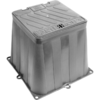Need to fit earth rod for a TT circuit.
The ground is very hard, is there any reason against pushing a 3’ long drill in first, give a chance on getting the whole 8’ rod in.
Ground is built up, clay & stone.
(Digging trench for cable was incredibly hard going)
The ground is very hard, is there any reason against pushing a 3’ long drill in first, give a chance on getting the whole 8’ rod in.
Ground is built up, clay & stone.
(Digging trench for cable was incredibly hard going)


